Knowledge Activity Support System Based on Discussion Content
Abstract
We have developed a system to support knowledge activity. Knowledge activity isactivity in which people continuously create ideas about themes and developthem into knowledge. First, the system generates minutes (linked to video andaudio of discussions) and metadata (on significant discussions). Then, userstag the minutes in order to identify certain parts contemplate the discussioncontent and write notes derived from the minutes with the system for use asdiscussion content. The system converts ideas in notes, generated throughordinary tasks, into presentation material for subsequent discussion. It ispossible to support knowledge activities by repeatedly using this system.
1 Introduction
In knowledge activities, such as those in project planning in enterprises orresearch in universities, people continuously generate knowledge on variousthemes by performing common tasks such as information retrieval. We thinkknowledge activities will be improved by creating secondary content that istaken from knowledge generated in repeated cycles of knowledge activities.
Discussion plays an important role in knowledge activities. The knowledgegenerated by a closed community is dominated by the ideas held by thatcommunity. Since there are probably different points of view in othercommunities, people present and discuss knowledge generated by their ownclosed activities with people outside that community. We believe that it ispossible to receive advice, to hear opinions and to review policy on knowledgeactivities through such discussion.
What we are concerned with here is that the content of an argument is forgottenwith the passage of time. Consequentially, it is necessary to record thecontent in some way and to create hints on beneficial discussion. A lot ofstudies on systems that mechanically record the content of a discussion havebeen done in the past. Such studies include work on recording information notonly as text information but also as audio-visual information and presentationmaterial. By keeping minutes, the presenter can think about his or her ownpresentations, convey knowledge smoothly and efficiently, and improve the nextpresentation.
There has been little research on ways to utilize discussion content. However,there are close interrelationships between generating and utilizing it.Therefore, it is necessary to think not only of ways of generating discussioncontent but also ways of utilizing it.
In this paper, we first describe the features of knowledge activities anda knowledge activity support system (KASS) (Section 2). We then introducediscussion mining, a method that we developed as an environment in whichdiscussion content can be created and browsed (Section 3). In Section 4, wedescribe the use of discussion contents created by discussion mining and adescription of the discussion, reflection, investigation, preparation (DRIP)system. In Section 5, we describe some applications of the combination ofdiscussion mining and DRIP systems. We then discuss the effectiveness of KASS.
2
3 Knowledge Activities
In our research, we focused on discussion, which is a knowledge activity. Forexample, a discussion is something like a seminar at a university, in which apresenter makes a presentation using knowledge that has been obtained from thepresenter's own knowledge activity and participants ask questions about contentthey do not understand and express their opinions on the content they dounderstand. We think discussion has two roles: one is to disclose knowledgeaccumulated through previous knowledge activity to the public and the other isto share ideas with participants.
3.1 Predominant Features
Research into a system for creating minutes for the reuse of argument contenthas been conducted a number of times ,.Lee proposed a method that records theparticipants' actions using cameras and microphones and then produces indexedminutes using auto-recognition technology. Chiu integratedaudio-visual information and information for presentation materials. We havedeveloped a method to document, retrieve, and browse arguments that occurduring a seminar as discussion contents. It is done by a method calleddiscussion mining.

Fugure1: DRIP Cycle
-
Discussion Phase
-
Reflection Phase
-
Investigation Phase
-
Preparation Phase
We conducted a questionnaire survey to 7 people from our laboratory.Each respondent made presentations about own research theme using thediscussion mining for 10 months, then checked arguments in the presentations inorder of date and answered questions about each arguments: whether he/sheremembered the argument content, considered the argument important to performcommon tasks and practically performed.
A questionnaire result shows that about 74\% of arguments made 10 months agoare forgotten while most recent arguments are little forgotten; the content ofan argument is forgotten with the passage of time. It also shows that about21\% of arguments well before 6 months, which respondents are felt important,are not reflected on common tasks. If not only arguments respondents rememberedwhen the questionnaire was made but also arguments forgotten are included, thevalue may become bigger. We think they are forgotten because certain discussionsare postponed because they are deemed future works or because the actualdiscussion topic is not brought to the attention of relevant people. Thequestionnaire also revealed that it is not sufficient to merely create minutesin order for knowledge activities to be properly performed.
Based on this point of view, we regard knowledge activities process as thecycle of four phases listed below.
In the discussion phase, we present the ideas and products presentation withmaterial and discuss with participants. Arguments give birth to new advice andopinion because of understanding from several points of view. So as not towaste these desirable arguments, we then arrange arguments in the reflectionphase. In the investigation phase, we create and record new ideas and productsbased on the past arguments. We create presentation material for nextdiscussion with conversion from the recorded ideas. We get feedback again viadiscussion in a presentation using created material.
We consider that knowledge activities advance through circulatingthese four phases shown in Figure . Once this cycle rides the entire loop, it isnot a cause for concern where the starting point of this cycle is. We defineknowledge activities' process with this cycle "DRIP (Discussion-Reflection-Investigation-Preparation) cycle".
We think that it is important to associate the knowledge generated throughvarious works with discussion as a trigger for the generation of more knowledgein the drip cycle. As a result, a person can understand what knowledge isgenerated by discussion, moreover, decrease the amount of discussion that isneglected by warning of the existence of discussion that is not related to theknowledge being generated.
Linking information connecting a discussion and the knowledge generated fromthe discussion can also lead to better presentations. A presenter can arrangethe content of a presentation and the participants can better understand thecontext of the presentation. The participants are especially motivated todiscuss the content of a presentation because they can make sure that their ownremarks are reflected in the presenter's knowledge activity.
An important function of a discussion is to change the way participants conducttheir knowledge activities. The participants may not have the same perspectiveas the presenter's on his or her knowledge activity. For this reason,opportunities for several people to meet and share a presenter's knowledge areimportant.
3.2 Knowledge Activity Support System
The purpose of this research is to develop a system to record discussionarguments as discussion content and to activate user knowledge activityusing this discussion content. To accomplish this, we have developed a systemcalled a knowledge activity support system. KASS contains twoenvironments (Figure ): thediscussion mining environment in which discussion content is generated andbrowsed and the DRIP environment in which generated discussion content is used.

Fugure2: Knowledge Activity Support System
In the discussion mining environment correspond to the discussion phase in thedrip cycle , reusable discussion content is generated by gathering real-worldinformation from text, video, metadata, etc. on discussions that take place inface-to-face meetings and semi-automatically structuring this information.Furthermore, there is an interface for efficiently browsing discussion contents.
The DRIP system provides functions to arrange discussion content from their ownviewpoints in the reflection phase, to record any newly generated ideas asnotes and relationships with the discussion content and notes in theinvestigation phase. The system can also provide accumulated information aboutdiscussion content and notes for making presentation materials in thepreparation phase.
The participants in a seminar may have concerns and their own position, policyand practice on a certain knowledge activity. Therefore, it is very useful forthe presenter to have a discussion with participants who have different ideasand knowledge because of the potential to get feedback via comments andopinions. For example, an investigation based on advice about relevantinformation can lead to further knowledge being acquired and confirmation ofhis or her activity's position in and benefit for society. Discussion thusinfluences normal research and knowledge accumulation. Furthermore, problems aswell as new knowledge are discovered. More feedback can be acquired by furtherdiscussion. We believe that knowledge activities advance by combining discussionand normal research.
4
4.1
4.2
5 Discussion Mining
We have developed a method called discussion mining ,which semi-automatically generates reusable discussion content. Real-worldinformation, such as text information, audio-visual information, and metadata,is recorded and structured as discussion content. Discussion mining consists ofa discussion recorder, which is an environment in which discussion content isgenerated, and a discussion browser, which is an environment in whichdiscussion content can be effectively browsed.
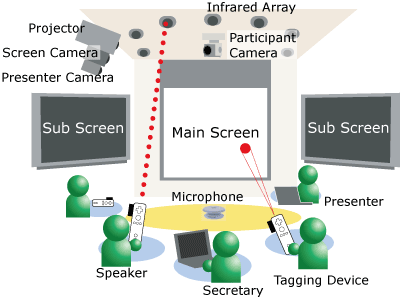
Fugure3: Discussion Recorder
5.1 Discussion Recorder
We analyze meetings not only with natural language processing to support thecomprehension of arguments in a discussion but also form diversifedperspectives using auditory and visual information in slides and otherpresentation content, and we use metadata to deal with the discussion content.The discussion recorder supports the creation of discussion content forface-to-face meetings, records the meeting environment with cameras andmicrophones, and writes meta-information that relates content in an XML database.
Most studies that provide technology for discussions and generating minuteshave focused on automatic recognition techniques for auditory and visual data,such as meeting browsers . We have developed a discussionrecorder for generating the content from meetings in a more semantic manner. Indiscussion mining, human activity in the real world is recorded using two ormore cameras and microphones. We target meetings that include a presenter, asecretary, and participants, and the presenter presents her or his agenda byusing Microsoft PowerPoint. Figure shows an image of thediscussion room.
The presenter uses a browser-based interface to display slides and to changethem. The information is recorded automatically. Participants in the meetingtransmit their IDs and comment types using tag devices called discussion tagsin order to properly structure the discussion. A secretary records anyarguments using a browser-based interface. A record of the arguments in XML andMPEG-4 format is saved as discussion content in an XML database.
5.2 Discussion Browser
The information accumulated by the discussion recorder is presented asdiscussion content in the discussionbrowser. Figure shows the construction of the discussion browser.
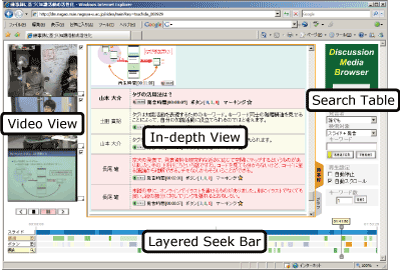
Fugure4: Discussion Browser
This browser screen consists of (1) a video view, (2) an in-depth view, (3) asearch table, and (4) a layered seek bar. The video view provides videos ofthe discussion, including the participants, presenter, and screen. The in-depthview consists of a text-based view, which display any discussion content thatis text information, and a graph view, which displays the structure of thediscussion. Users can toggle between these views. In the search table, threetypes of search query are available: speaker ID, the target of the search(either the contents of the slide or statement, or both), and keywords. Theelements which compose discussion content are displayed in the layered seekbar. The discussion browser enables searching and browsing of the details ofthe discussion that correspond to user queries. For example, when a participantof a discussion wants to refer to certain important previous discussions, theparticipant will search for statements by using keywords or speakers' names andthen browse the details of the statements in the search results.
6
6.1
6.2
7
7.1
7.2
7.3
8 DRIP System - Utilization of Discussion Content
The DRIP system is a server/client system. The client application has threemain functions: arranging discussion content created by discussion mining,creating a memorandum of generated knowledge, and creating presentationmaterials using the information accumulated. The server manages datatransferred from the client and conducts periodic auditing and notification ofusers' knowledge activity.
8.1 Tagging Discussion Content
When past discussion is not been dealt with, they are forgotten. As a result,the amount of forgotten discussion content increases. The DRIP system enablesusers to arrange discussion content so that it is less easily forgotten.
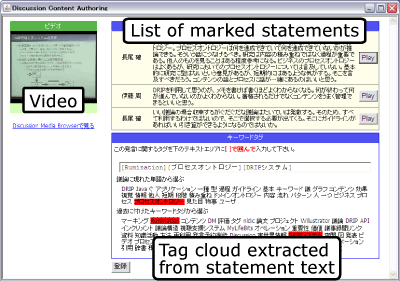
Fugure5: Discussion Content Tagger
Figure shows an example of the interface used when arrangingdiscussion content with the DRIP system. There are various kinds of discussion.For example, important ones that affect a presenter's knowledge activity andless important ones that involve questions and answers. Users thus can markstatements evaluated important in the discussion content using this interface.The DRIP system can be used during and after discussion.
The user can also tag the discussion content for searching. This is because itis not possible to tell from context alone why certain marked statements areimportant. Determining why something is important is difficult using automaticrecognition techniques on audio and visual data. The DRIP system has twotagging methods: one for tagging new data and one for tagging a tag cloudcontaining past tags. The DRIP system prevents users overlooking discussioncontent by warning the user that certain discussion content has not beenarranged.
Marking and tagging discussion content enables the user to efficiently searchfor relevant arguments. A result on discussion content retrieved using the DRIPsystem is shown as a list of selected statements. The system redirects users tothe discussion browser so that they can browse details of specific discussioncontent.
8.2 Note Writing - Derivations of Discussion Content
Users can note knowledge generated by work based on discussion content with theDRIP system. Figure shows the interface for writing notes.The interface includes a discussion content viewer, a note editor, and linkinginformation. When an idea occurs to the user while browsing discussion content,the user inputs the idea using the note editor, which is opened by clicking anicon in the discussion content viewer. Linking information, which explains therelationship between discussion content and notes, appears as an arrow betweenthe discussion content viewer and the note editor. The user can also linkdiscussion content and notes by dragging the note editor to other discussioncontent viewers.
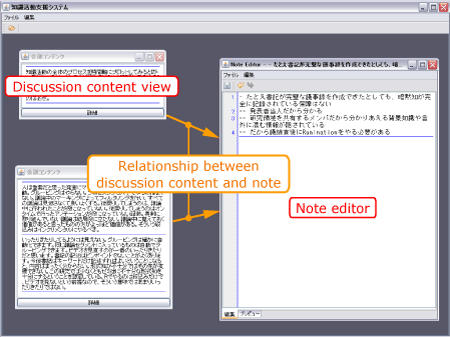
Fugure6: Annotating Discussion Content with Personal Notes
The server in the DRIP system manages all data displayed and input via the noteeditor. Thus, the DRIP system creates a synchronized environment acrossdifferent PCs. The server regularly checks for discussion content that has notbeen annotated or viewed for a certain period of time. The server notifies theuser of such content in order to decrease the amount of forgotten discussion.
8.3 Creating Presentation Materials for Next Discussion
Knowledge generated in work based on past discussion content is very useful forfurther discussion. This knowledge should be included in presentation materialfor future discussion. The DRIP system helps the user make presentationmaterials with an interface called presentation material creator, as shown in Figure .The presentation material creator has the following functions:
-
Creation, deletion, reordering of slides
-
Importing of accumulated notes into slides
-
Conversion of slides into a PowerPoint document
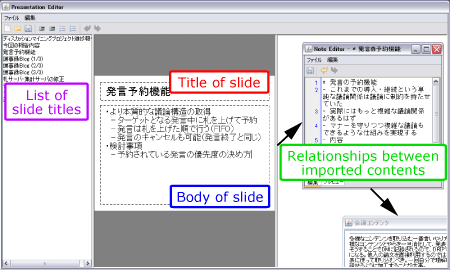
Fugure7: Presentation Material Creator
The user makes an outline of his or her presentation material by creating,deleting and reordering slides. The slides will be in a format such asMicrosoft PowerPoint. Each slide, which contains a title, text body and aunique ID, is a derivative document of notes.
To include the accumulated knowledge in the presentation material, the userconducts an operation called ``Import''. For the import, the system retrievenotes based on keywords or dates. When the user searches using dates, a historyof note edits starting from the query date is returned. It is thus possible toinclude a difference value in the slides of the user's knowledge activity fromprevious discussions. The contents of the retrieval results are insertedautomatically into the text body editor by dragging and dropping. This functionis used to make complete slides.
The presentation material creator converts the completed slides into aPowerPoint document and transfers information about importing the contentsinto slides to the server. The information is made available in the discussionrecorder. It is useful to display such information on sub screens in order tohelp participants understand presentations.
9
10 Application of KASS
KASS provides functions enabling users to relate discussion content andnotes and to create presentation materials using discussion content and/ornotes. Each time the system is used, the relationships between discussioncontent and notes will increase (Figure ). Weregard the relationships as contextual information on knowledge activities.

Fugure8: Relationships between Discussions via Notes
We believe it is possible to improve the understanding of the background to auser's knowledge activity by using an interface to efficiently browse thecontextual information on the discussion browser. When the user browsesinformation about his or her own activity, this knowledge activity willbecome more meaningful by determining its significance or assigning it to aparticular activity.
Moreover, knowledge management can be supported by sharing the contextualinformation within a group. For instance, a person newly assigned to a projecthas little knowledge concerning previous approaches used in the project. Inthis case, contextual information on the knowledge activities of others may helpthe person to better understand these previous approaches.
Studies on systems that store and collate personal information quickly andflexibly have been done , . Most studies have focusedon storing content metadata, such as a title of an article, a URL, and creationdates. However, we believe that information on relationships between content isnecessary for retrieving useful information.
There are two methods of acquiring information relating contents: one is anautomatic recognition technique, such as natural language processing and imagedata processing, and the other is manual input. Because of the difficulty ininterpreting semantic content by machine, the accuracy of the former method isnot adequate. The problem with the manual input method is that it is expensive.However, we believe that relationships between content can be acquired easilyusing KASS due to tacit acquisitions based on users' natural activity.
11
12 Conclusions and Future Work
This paper describes KASS. Discussion mining, which is part of the system,generates reusable content linked to video and audio data of discussions andmetadata. Users can then arrange and use the discussion content with the DRIPsystem. It is possible to perform knowledge activities by repeatedly using KASS.
-
Evaluation of KASS
-
Activation of discussion by using information accumulated when creating presentation material
-
Implementation of a system that supports not only individual knowledge activities but also cooperative knowledge activities within a group
Future research will concentrate on the items listed below.
